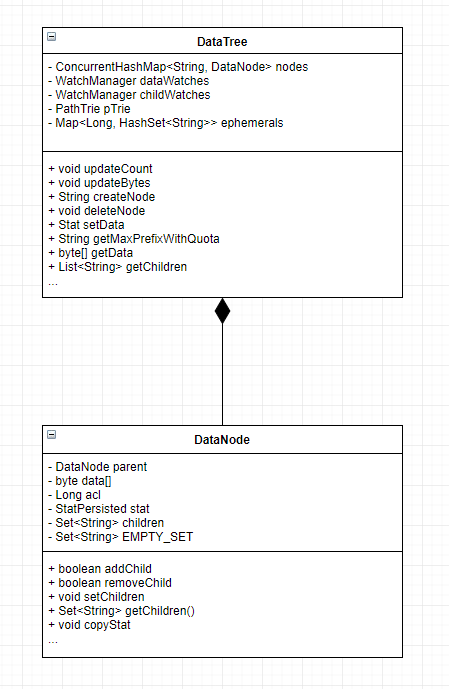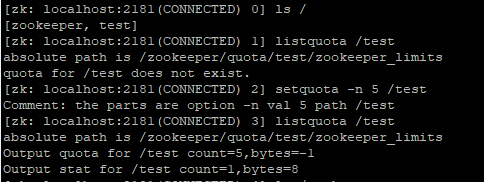Zookeeper源码阅读(二)数据存储
前言
在开始写具体的逻辑之前,还需要把zk的数据管理和事务的日志与保存了解得更深入一些。这部分内容不少,下面几篇都会是相关的内容。
内存数据
zk的数据结构模型是基于ZNode的树状模型。在ZK内部通过类似内存数据库的方式保存了整棵树的内容,并定时写入磁盘。
zk的内存数据放在DataTree中,它是zk内存数据存储的核心,也是一个树形结构。
/**
* This class maintains the tree data structure. It doesn't have any networking
* or client connection code in it so that it can be tested in a stand alone
* way.
* <p>
* The tree maintains two parallel data structures: a hashtable that maps from
* full paths to DataNodes and a tree of DataNodes. All accesses to a path is
* through the hashtable. The tree is traversed only when serializing to disk.
*/
public class DataTree {
private static final Logger LOG = LoggerFactory.getLogger(DataTree.class);
/**
* This hashtable provides a fast lookup to the datanodes. The tree is the
* source of truth and is where all the locking occurs
*/
private final ConcurrentHashMap<String, DataNode> nodes =
new ConcurrentHashMap<String, DataNode>();
private final WatchManager dataWatches = new WatchManager();
private final WatchManager childWatches = new WatchManager();
/** the root of zookeeper tree */
private static final String rootZookeeper = "/";
/** the zookeeper nodes that acts as the management and status node **/
private static final String procZookeeper = Quotas.procZookeeper;
/** this will be the string thats stored as a child of root */
private static final String procChildZookeeper = procZookeeper.substring(1);
/**
* the zookeeper quota node that acts as the quota management node for
* zookeeper
*/
private static final String quotaZookeeper = Quotas.quotaZookeeper;
/** this will be the string thats stored as a child of /zookeeper */
private static final String quotaChildZookeeper = quotaZookeeper
.substring(procZookeeper.length() + 1);
/**
* the path trie that keeps track fo the quota nodes in this datatree
*/
private final PathTrie pTrie = new PathTrie();
/**
* This hashtable lists the paths of the ephemeral nodes of a session.
*/
private final Map<Long, HashSet<String>> ephemerals =
new ConcurrentHashMap<Long, HashSet<String>>();
private final ReferenceCountedACLCache aclCache = new ReferenceCountedACLCache();
...
可以看到DataTree主要和四个类有关联关系,即DataNode,Quotas,PathTrie,StatsTrack。接下来会逐个说一下。
DataNode
DataNode类是zookeeper中数据存储的最小单元。在DataTree中,private final ConcurrentHashMap<String, DataNode> nodes = new ConcurrentHashMap<String, DataNode>();所有的datanode存在一个concurrentHashMap中,对zk中所有的znode进行操作,其实底层就是对这个map进行操作。其中path是key,datanode是value。
特别的是,对于所有的临时节点,private final Map<Long, HashSet<String>> ephemerals = new ConcurrentHashMap<Long, HashSet<String>>();专门有一个map去存它们,便于实时的访问和session结束后的集中清理。

其中,DataNode类的代码:
public class DataNode implements Record {
/** the parent of this datanode */
DataNode parent;
/** the data for this datanode */
byte data[];
/**
* the acl map long for this datanode. the datatree has the map
*/
Long acl;
/**
* the stat for this node that is persisted to disk.
*/
public StatPersisted stat;
/**
* the list of children for this node. note that the list of children string
* does not contain the parent path -- just the last part of the path. This
* should be synchronized on except deserializing (for speed up issues).
*/
private Set<String> children = null;
可以看到,DataNode中存储的信息共有三类,数据内容data[],acl列表和节点状态stat。其中数据内容和节点状态就是在客户端上getdata获取到的那些数据。同时,DataNode中还记录了节点的父节点和子节点列表,并提供了对子节点列表的操作。
加孩子:
/**
* Method that inserts a child into the children set
*
* @param child
* to be inserted
* @return true if this set did not already contain the specified element
*/
public synchronized boolean addChild(String child) {
if (children == null) {
// let's be conservative on the typical number of children
children = new HashSet<String>(8);//初始化
}
return children.add(child);//加入set中
}
删孩子:
/**
* Method that removes a child from the children set
*
* @param child
* @return true if this set contained the specified element
*/
public synchronized boolean removeChild(String child) {
if (children == null) {
return false;
}
return children.remove(child);//把孩子从set中移除
}
get/set:
/**
* convenience method for setting the children for this datanode
*
* @param children
*/
public synchronized void setChildren(HashSet<String> children) {
this.children = children;
}
/**
* convenience methods to get the children
*
* @return the children of this datanode
*/
public synchronized Set<String> getChildren() {//get/set中都加同步,避免了多线程请求时对共享变量形成竞态条件
if (children == null) {
return EMPTY_SET;
}
return Collections.unmodifiableSet(children);
}
都是很简单的方法,配合注释应该很容易看懂。
Quotas
在看后面的内容前,强烈建议看一看zk权限管理与配额。Quotas其实就是为ZNode设置的节点个数和数据量大小的限制(只是在日志中会提醒,并不是真正限制)。
public class Quotas {
/** the zookeeper nodes that acts as the management and status node **/
public static final String procZookeeper = "/zookeeper";
/** the zookeeper quota node that acts as the quota
* management node for zookeeper */
public static final String quotaZookeeper = "/zookeeper/quota";
/**
* the limit node that has the limit of
* a subtree
*/
public static final String limitNode = "zookeeper_limits";
/**
* the stat node that monitors the limit of
* a subtree.
*/
public static final String statNode = "zookeeper_stats";
limitnode和statnode的区别:一个是在set quota是的限制,一个是真实的情况。这个会在后面说PathTrie的时候说下。这里说明一点,所有成功设立了quota的节点都会在/zookeeper/quota下建立一个树形的数据结构,并且每个节点都会有两个孩子接点,即path+"zookeeper_limits"和path+"zookeeper_stats"。分别对应上面的limitnode和statnode。特别的是,前面这句话中成功设立是有条件的,如果发现有父节点或者兄弟孩子节点有quota,那么设置quota会失败。
public static String quotaPath(String path) {
return quotaZookeeper + path +
"/" + limitNode;//limitnode
}
public static String statPath(String path) {
return quotaZookeeper + path + "/" +
statNode;//statnode
}
上面两个方法负责statnode和limitnode的路径生成。
PathTrie
关于字典树的简介,可以看一下 浅谈字典树。我自己简单理解了一下,大概就是如果单词有公共字串(从第一个字母开始的),那么这部分公用,剩下的再建立新的接点。
public class PathTrie {
/**
* the logger for this class
*/
private static final Logger LOG = LoggerFactory.getLogger(PathTrie.class);
/**
* the root node of PathTrie
*/
private final TrieNode rootNode ;
static class TrieNode {
boolean property = false;//表示当前节点是否有配额
final HashMap<String, TrieNode> children;
TrieNode parent = null;
结构很简单,就是典型的树结构,其中静态内部类TrieNode是节点。
前面说到的一点,果发现有父节点或者兄弟孩子节点有quota,那么设置quota会失败。为什么会这样其实是在PathTrie里控制的,而且这点之前看了很多博客都没提到,一定要注意。



可以从上面三张图片里看到,一旦给一个节点加了quota之后,给它的父节点和子节点加quota都会失败。
原因:
public void addPath(String path) {
if (path == null) {
return;
}
String[] pathComponents = path.split("/");//把路径按照/分开
TrieNode parent = rootNode;
String part = null;
if (pathComponents.length <= 1) {
throw new IllegalArgumentException("Invalid path " + path);
}
for (int i=1; i<pathComponents.length; i++) {//一层一层查
part = pathComponents[i];
if (parent.getChild(part) == null) {
parent.addChild(part, new TrieNode(parent));////找到位置,插入
}
parent = parent.getChild(part);
}
parent.setProperty(true);
}
从这里看,确实是按照字典树的规则插入的,但是在zk接受客户端命令的位置在ZookeeperMain中processCMD方法中:
if (cmd.equals("setquota") && args.length >= 4) {
String option = args[1];
String val = args[2];
path = args[3];
System.err.println("Comment: the parts are " +
"option " + option +
" val " + val +
" path " + path);
if ("-b".equals(option)) {
// we are setting the bytes quota
createQuota(zk, path, Long.parseLong(val), -1);//发送setquota命令后真正添加节点的
} else if ("-n".equals(option)) {
// we are setting the num quota
createQuota(zk, path, -1L, Integer.parseInt(val));
} else {
usage();
}
}
这里可以看到setquota中有一个createQuota方法,其中:
/ check for more than 2 children --
// if zookeeper_stats and zookeeper_qutoas
// are not the children then this path
// is an ancestor of some path that
// already has quota
String realPath = Quotas.quotaZookeeper + path;
//检查孩子节点中是否已经有quota
try {
List<String> children = zk.getChildren(realPath, false);
for (String child: children) {
if (!child.startsWith("zookeeper_")) {
throw new IllegalArgumentException(path + " has child " +
child + " which has a quota");
}
}
} catch(KeeperException.NoNodeException ne) {
// this is fine
}
//check for any parent that has been quota
//检查父节点中是否有quota,可以点进去看,逻辑和判断孩子的差不多的。
checkIfParentQuota(zk, path);
在这里判断了一下后,这也就导致了我先前描述的那种情况,为什么在父节点和子节点有quota时无法添加的quota。特别重要的是,这个判断在客户端就完成了判断。如果父节点和子节点没有quota,客户端会发送请求到服务端创建节点(代码在ZookeeperMain中),如下所示:
!!!这里我之前说错了!!!!并不是仅仅依靠客户端就完成了判断,需要与服务器通信的。List
if (zk.exists(quotaPath, false) == null) {
try {
//在create内部会将请求发送到服务器端。
zk.create(Quotas.procZookeeper, null, Ids.OPEN_ACL_UNSAFE,
CreateMode.PERSISTENT);
zk.create(Quotas.quotaZookeeper, null, Ids.OPEN_ACL_UNSAFE,
CreateMode.PERSISTENT);
} catch(KeeperException.NodeExistsException ne) {
// do nothing
}
}
如果想了解字典树的添加和删除,可以看一下 Zk数据模型-配额。
StatsTrack
StatsTrack其实就是记录某个接点实际的count和bytes信息。
/**
* a class that represents the stats associated with quotas
*/
public class StatsTrack {
private int count;
private long bytes;
private String countStr = "count";
private String byteStr = "bytes";
StatsTrack其实就是个实体类,存的就是字典树中statnode节点的数据。下面的代码就是生成statnode时的代码,可以看到,是把statstrack转化为字符串后放入statnode中作为它的内容。
StatsTrack strack = new StatsTrack(null);
strack.setBytes(bytes);
strack.setCount(numNodes);
try {
zk.create(quotaPath, strack.toString().getBytes(),
Ids.OPEN_ACL_UNSAFE, CreateMode.PERSISTENT);
StatsTrack stats = new StatsTrack(null);
stats.setBytes(0L);
stats.setCount(0);
zk.create(statPath, stats.toString().getBytes(),
Ids.OPEN_ACL_UNSAFE, CreateMode.PERSISTENT);
}
思考:
有时间可以再仔细研究研究quotas的原理。
不清楚的几点:
为什么父节点、子节点有quota就不让添加了呢???为什么要这样设计。



